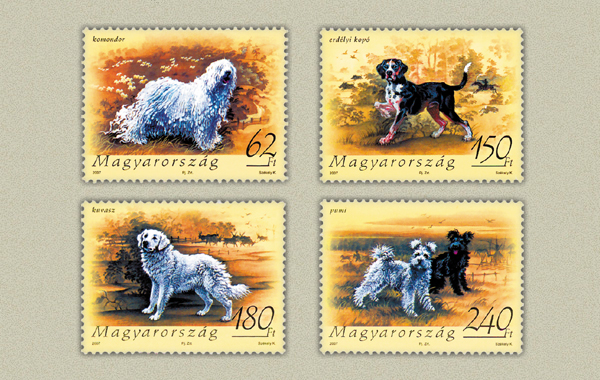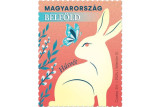
1. MAGYAR - ÉLŐ ÖRÖKSÉGÜNK III. - KUTYÁK - SOR - Bélyeg rendelési kód: 2007 év bélyegei kompletten
2. ENGLISH - OUR LIVING HERITAGE III. – DOGS - SET - Order code of the stamp: 2007 Year stamps complete
3. GERMAN - Unser lebendiges Erbe III. - Hunde - ROW - Marke die sprechstunde kode: 2007 Jahr Briefmarken komplett
1. MAGYAR - ÉLŐ ÖRÖKSÉGÜNK III - KUTYÁK - SOR
A Magyar Posta alkalmi bélyegblokk és négy címletből álló bélyegsorozat kibocsátásával mutat be néhány jellegzetes hazai kutyafajt.
A komondor ázsiai eredetű, ősi magyar pásztorkutyafajta. Robosztus testét mindenütt nemezesedésre hajlamos, gubancos, dús, hosszú szőrzet fedi. Nappal szeret elfeküdni, de úgy, hogy területét ellenőrizhesse. Éjjel rendületlenül mozog. Vérmérséklete élénk. Nem barátkozó természetű, alapvetően bizalmatlan. Gazdájához feltétel nélkül ragaszkodik, de rendkívül önálló is. Jelleme határozott. Hang nélkül, vakmerően támad.
Az erdélyi kopó a történelmi Magyarországon alakult ki. Az erdélyi magyarság dolga volt a kopók tenyésztése és alkalmazása a vadászatokon. Az általuk végzett hajtóvadászat kitartást, bátorságot, a nyomkövetést lehetővé tevő éles szimatot, kiváló memóriát és tájékozódó képességet kívánta meg, és ez a követelmény segítette a fajtát. Jóindulatú, bátor, nyugodt, alaptermészete kiegyensúlyozott, ugyanakkor határozott, temperamentumos.
A kuvasz egyes feltételezések szerint a honfoglaló magyarokkal érkezett hazánkba. Nagy termete miatt állatok őrzésére, védelmére használták. Fehér színe, hullámos szőrzete, tetszetős külseje, nemességet, erőt sugároz. Futva nagy távok megtételére is képes különösebb fáradság nélkül. Rendkívüli intelligenciája a pásztorok szelekciójának következménye. Nagyon könnyen játszva tanul és nem felejt.
A pumi a puli és a francia eredetű terrier jellegű pásztorkutya spontán kereszteződéséből alakult ki. A nagytestű, nyájak őrzését végző juhászkutyák mellett szükség volt ugyanis kistermetű terelőkutyákra is. Értelmes, rámenős természetű, hangos, jó szimatú fajta. A szőrzete a puliéval ellentétben nem nemezesedik és rövidebb is. Fáradhatatlan, szinte mindenre megtanítható, ami erejéhez és testtartásához képest megvalósítható.
Megjelenési időpont: 2007. május 9.
Forrás: Philatelia Hungarica Kft., Magyar Posta
2. ENGLISH - OUR LIVING HERITAGE III – DOGS - SET
Magyar Posta presents breeds of dogs typical of Hungary by issuing a special stamp block and a set of four stamps.
The wire-haired Hungarian vizsla appeared among the national hunting dogs of Hungary barely half a century ago. The thought that prompted the creation of the breed was that the short-haired Hungarian vizsla with its excellent quali-ties deserved a “protective coat” for snow and water in bitter winter weather, just like the German wirehaired pointer. It is a lively, friendly, well-balanced dog which is easy to train and makes strong bonds with people.
The komondor is an ancient Hungarian sheepdog of Asian origin. Its sturdy body is entirely covered by thick long shaggy fur that is inclined to become matted. By day it likes to lie for long periods watching over its territory. By night it moves persistently. It has a lively temperament. It does not have a friendly nature and is naturally suspicious. It is absolutely loyal to its owner, but is also highly independent with a strong character. It attacks boldly without a sound.
The Transylvanian hound developed in historic Hungary. The Hungarians in Transylvania bred and used these hounds for hunting. The style of drive hunting required persistence and courage, and a keen sense of smell, excellent memory and sense of direction make these hounds ideal for spooring. They are goodnatured, brave, calm and well-balanced, yet determined and lively.
According to some sources, the kuvasz came to Hungary when the Magyar tribes settled in the Carpathian Basin. Due to its large build, it was used to watch over and protect livestock. Its white, wavy fur and pleasing appearance radiate nobility and strength. It can run long distances without tiring. Its extraordinary intelligence is a consequence of selection by the shepherds. It learns with ease and does not forget.
The pumi developed from the spontaneous crossing of the Hungarian breed puli and a terrier-like sheepdog of French origin, as besides large sheepdogs minding the flock smaller sheepdogs were also needed. A clever and loud breed with a pushy nature and a keen sense of smell, its fur is shorter than the puli’s and does not get matted. It never tires and can be taught to do almost anything that its strength and build allows.
In the frame and the stamp design of the block a wire-haired Hungarian vizsla is depicted as part of a graphic composition recalling its usual environment. In the denominations of the set of stamps typical Hungarian breeds are shown. As in the block, the graphic designs have a coloured background and motifs referring to the surroundings associated with the dogs. On the stamp designs, in order of face value, the following breeds are shown: the komondor, Transylvanian hound, kuvasz and pumi. The special cover features a scene showing a flock being herded. The special postmark is a stylised drawing of a kuvasz. Source: www.magyarallat.hu
Date of issue: 9 May 2007
3. GERMAN - Unser lebendiges Erbe III. - Hunde - ROW
Die Ungarische Post-hoc-Miniatur-und vier Stempel Stückelung der Frage stellt einige typische Haushunde.
Der Komondor asiatischer Herkunft, der alten ungarischen pásztorkutyafajta. Robuste Körper aller verfilzt, verstrickt, dichte, lange Behaarung. Elfeküdni wie Tage, aber das Gebiet zu überprüfen. Stetig bewegt in der Nacht. Lebhaftem Temperament. Nicht Kumpel, grundsätzlich unsicher. Halten Sie unbedingt Meister, sondern auch sehr eigenständig. Starken Charakter. Ohne Ton, kühn anzugreifen.
Die Tiroler Bracke des historischen Ungarns entwickelt. Die Ungarn in Siebenbürgen, hat er die Zucht und die Verwendung von Jagdhunde wurde. Chase sie aus dem Ausdauer, Mut, so dass die Verfolgung der scharfe Duft von Hochleistungs-Speicher, und explorative wollte, und hat dazu beigetragen, diese Anforderung zu züchten. Gutmütig, mutig, ruhig, ausgewogen grundlegender Art, aber stark und lebendig.
Der Hund einige Annahmen der siegreichen Ungarn aus Ungarn. Große Figur, weil die Bewachung der Tiere, wurde der Schutz verwendet werden. Weiße Farbe, welliges Haar, schönes Aussehen, Adel, eingeschaltet ist. Running großen Entfernungen kann ohne besondere Anstrengung. Die Auswahl durch die außergewöhnliche Intelligenz der Hirten. Es ist sehr leicht zu spielen lernen und nicht zu vergessen.
Der Puli Pumi und der Art der Terrier von Französisch Herkunft, entwickelt spontane Kreuzungen. Die großen, Herden, war es im Rahmen der Verwahrung von Hunden, die terelőkutyákra wäre zu klein notwendig. Intelligent, Durchsetzungsvermögen in der Natur, Sound, Art eines guten Spürsinn. Die puliéval Gegensatz zu den verfilzten Haaren und kürzer. Unermüdlich, fast alle lernen können, was machbar ist in Bezug auf seine Stärke und Haltung.


